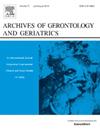Longitudinal bidirectional dynamic association between handgrip strength and cognitive function in Chinese older adults: a cross-lag modeling study
IF 3.8
3区 医学
Q2 GERIATRICS & GERONTOLOGY
引用次数: 0
Abstract
Objective
This study examined the bidirectional dynamic relationship between handgrip strength and cognitive function and the influence of gender and age differences among Chinese adults aged 60 and above.
Method
Data were derived from the 2013–2015 waves of the China Health and Retirement Longitudinal Study (CHARLS), including 4533 older adults. Cross-lagged panel models were used to analyze the temporal relationship between handgrip strength and cognitive function. Covariates covered sociodemographic characteristics, lifestyle factors, and health indicators. Data analysis was performed using SAS 9.4 and R 4.4.1.
Results
During the 2-year follow-up, both handgrip strength and cognitive function showed declining trends in older adults. Cross-lagged analysis revealed that baseline handgrip strength positively predicted follow-up cognitive function (P < 0.001), indicating that individuals with greater baseline grip strength maintained better cognitive performance. Conversely, baseline cognitive function also positively predicted follow-up handgrip strength (P < 0.001).These bidirectional associations exhibited gender differences: the predictive effect of handgrip strength on cognition was stronger in males (P < 0.001), whereas the effect of cognition on handgrip strength was more pronounced in females (P < 0.001). Age-stratified analysis demonstrated that the association between handgrip strength and cognition was strongest in the 70–79 age group (P < 0.001). However, this relationship weakened in adults aged 80 and above, potentially due to compensatory mechanisms or external environmental support.
Conclusion
A bidirectional muscle-cognition association exists in older adults, supporting the incorporation of handgrip strength testing into cognitive screening. Gender- and age-specific interventions should prioritize rural populations with low education and high-risk individuals aged 70–79 years. These findings provide a scientific basis for preventing cognitive decline in aging populations.
中国老年人握力与认知功能的纵向双向动态关联:一个交叉滞后模型研究。
目的:探讨中国60岁及以上成年人握力与认知功能的双向动态关系及性别、年龄差异的影响。方法:数据来源于2013-2015年中国健康与退休纵向研究(CHARLS),共纳入4533名老年人。采用交叉滞后面板模型分析了手握力与认知功能的时间关系。协变量包括社会人口特征、生活方式因素和健康指标。采用SAS 9.4和R 4.4.1进行数据分析。结果:在2年的随访中,老年人握力和认知功能均呈现下降趋势。交叉滞后分析显示,基线握力正预测随访认知功能(P < 0.001),表明基线握力越大的个体保持更好的认知表现。相反,基线认知功能也能正向预测随访的握力(P < 0.001)。这些双向关联表现出性别差异:握力对认知的预测作用在男性中更强(P < 0.001),而认知对握力的影响在女性中更明显(P < 0.001)。年龄分层分析表明,握力与认知的相关性在70-79岁年龄组中最强(P < 0.001)。然而,这种关系在80岁及以上的成年人中减弱,可能是由于代偿机制或外部环境支持。结论:老年人存在双向肌肉认知关联,支持将握力测试纳入认知筛查。针对性别和年龄的干预措施应优先考虑农村低教育人群和70-79岁的高危人群。这些发现为预防老年人认知能力下降提供了科学依据。
本文章由计算机程序翻译,如有差异,请以英文原文为准。
求助全文
约1分钟内获得全文
求助全文
来源期刊
CiteScore
7.30
自引率
5.00%
发文量
198
审稿时长
16 days
期刊介绍:
Archives of Gerontology and Geriatrics provides a medium for the publication of papers from the fields of experimental gerontology and clinical and social geriatrics. The principal aim of the journal is to facilitate the exchange of information between specialists in these three fields of gerontological research. Experimental papers dealing with the basic mechanisms of aging at molecular, cellular, tissue or organ levels will be published.
Clinical papers will be accepted if they provide sufficiently new information or are of fundamental importance for the knowledge of human aging. Purely descriptive clinical papers will be accepted only if the results permit further interpretation. Papers dealing with anti-aging pharmacological preparations in humans are welcome. Papers on the social aspects of geriatrics will be accepted if they are of general interest regarding the epidemiology of aging and the efficiency and working methods of the social organizations for the health care of the elderly.

 求助内容:
求助内容: 应助结果提醒方式:
应助结果提醒方式:


